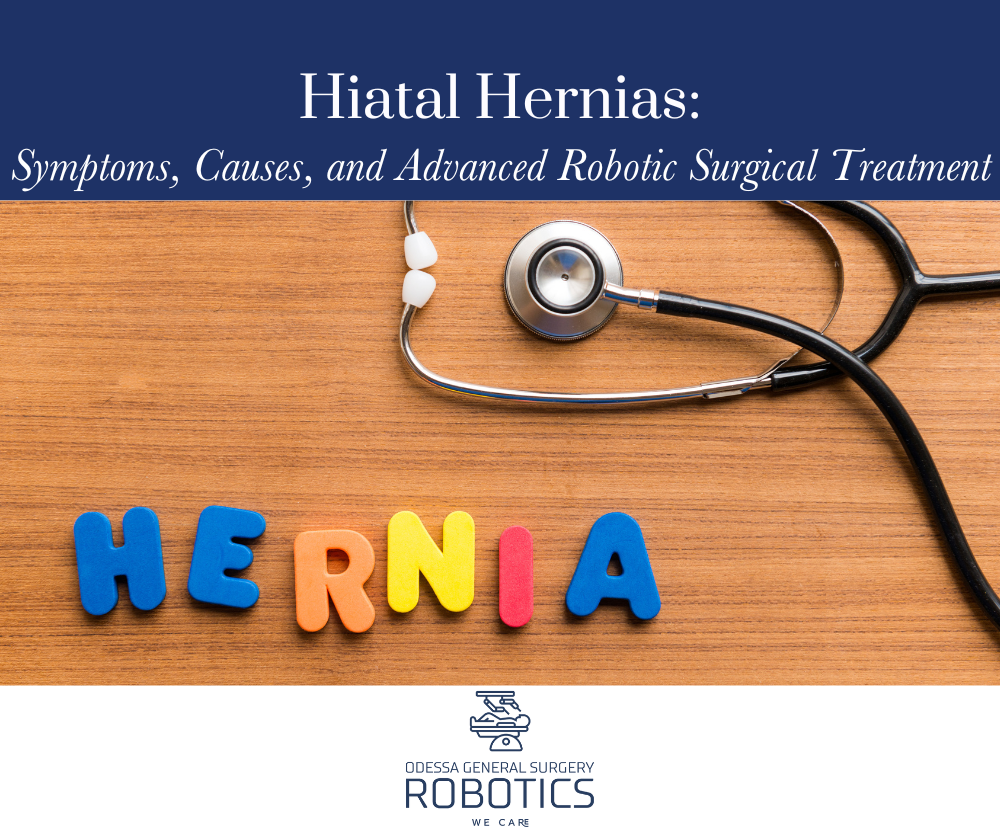 Hiatal hernias are a common medical condition affecting millions of people worldwide. Despite their prevalence, many individuals are unaware of the symptoms, causes, and advanced treatment options available. At Odessa General Surgery Robotics, we are committed to providing cutting-edge solutions to ensure the best possible outcomes for our patients.
Hiatal hernias are a common medical condition affecting millions of people worldwide. Despite their prevalence, many individuals are unaware of the symptoms, causes, and advanced treatment options available. At Odessa General Surgery Robotics, we are committed to providing cutting-edge solutions to ensure the best possible outcomes for our patients.
This comprehensive blog post will explore the intricacies of hiatal hernias and how robotic surgery can offer a minimally invasive and highly effective treatment option.
What is a Hiatal Hernia?
A hiatal hernia occurs when part of the stomach pushes through the diaphragm into the chest cavity. The diaphragm is a large muscle that separates the chest from the abdomen and helps with breathing. Normally, the stomach is located below the diaphragm, but in the case of a hiatal hernia, it moves up into the chest through an opening called the hiatus.
Types of Hiatal Hernias
There are two main types of hiatal hernias:
- Sliding Hiatal Hernia: This is the most common type, where the stomach and the section of the esophagus that joins the stomach slide up into the chest through the hiatus. Sliding hernias are typically small and may not cause significant symptoms.
- Paraesophageal Hiatal Hernia: In this less common but more serious type, part of the stomach pushes through the diaphragm and sits next to the esophagus. Although the stomach remains in place, the esophagus can become squeezed, leading to more severe symptoms and complications.
Symptoms of Hiatal Hernias
Many people with hiatal hernias may not experience symptoms, especially if the hernia is small. However, larger hiatal hernias can cause a range of symptoms, including:
- Heartburn
- Regurgitation of food or liquids into the mouth
- Difficulty swallowing
- Chest or abdominal pain
- Shortness of breath
- Feeling full quickly after eating
- Vomiting blood or passing black stools (a sign of gastrointestinal bleeding)
Causes and Risk Factors
The exact cause of hiatal hernias is not always clear, but several factors can contribute to their development:
- Age: Hiatal hernias are more common in individuals over 50.
- Obesity: Excess weight can put pressure on the abdomen, pushing the stomach through the diaphragm.
- Pregnancy: The increased pressure on the abdomen during pregnancy can lead to the development of a hiatal hernia.
- Heavy lifting: Frequent heavy lifting or straining can increase abdominal pressure, contributing to the formation of a hernia.
- Genetic predisposition: A family history of hiatal hernias may increase the likelihood of developing the condition.
Diagnosis
Diagnosing a hiatal hernia typically involves a combination of the following tests:
- Barium swallow: A special X-ray test where the patient drinks a barium solution that coats the esophagus and stomach, making them visible on X-ray images.
- Endoscopy: A thin, flexible tube with a light and camera (endoscope) is inserted down the throat to examine the esophagus and stomach.
- Esophageal manometry: This test measures the rhythmic muscle contractions of the esophagus when swallowing and the coordination and force exerted by the esophageal muscles.
Treatment Options
Treatment for hiatal hernias depends on the severity of symptoms and the type of hernia. Options include lifestyle changes, medications, and surgery.
- Lifestyle Changes:
- Eating smaller, more frequent meals
- Avoiding foods and drinks that trigger heartburn
- Losing weight if overweight
- Elevating the head of the bed
- Avoiding lying down after meals
- Medications:
- Antacids to neutralize stomach acid
- H2-receptor blockers to reduce acid production
- Proton pump inhibitors (PPIs) to block acid production and heal the esophagus
Surgery:
- When lifestyle changes and medications are not effective, or if the hernia is large and causing severe symptoms, surgery may be necessary.
Advanced Robotic Surgery for Hiatal Hernias
At Odessa General Surgery Robotics, we specialize in minimally invasive robotic surgery to treat hiatal hernias. Robotic surgery offers several advantages over traditional open surgery, including:
- Precision: Robotic systems provide surgeons with enhanced precision and control, allowing for meticulous dissection and suturing.
- Minimally Invasive: Smaller incisions mean less pain, reduced scarring, and a quicker recovery for patients.
- Reduced Complications: The advanced technology and techniques used in robotic surgery minimize the risk of complications.
The Robotic Surgery Procedure
During robotic hiatal hernia repair, the surgeon makes a few small incisions in the abdomen. A robotic system with a high-definition 3D camera and specialized instruments is used to perform the surgery. The surgeon controls the robotic instruments from a console, ensuring precise movements and optimal outcomes.
The procedure typically involves:
- Reducing the hernia by pulling the stomach back into the abdomen
- Strengthening the diaphragm around the hiatus
- Sometimes, performing a fundoplication, where the top part of the stomach is wrapped around the lower esophagus to prevent acid reflux
Recovery and Outlook
Recovery from robotic hiatal hernia surgery is generally quicker and less painful compared to traditional surgery. Most patients can return home within a day or two and resume normal activities within a few weeks. The minimally invasive nature of the surgery also results in lower infection rates and minimal scarring.
Conclusion
Hiatal hernias can significantly impact an individual’s quality of life, but with the advancements in robotic surgery, effective treatment is available. At Odessa General Surgery Robotics, we are dedicated to providing state-of-the-art care to our patients, ensuring they receive the best possible outcomes. If you are experiencing symptoms of a hiatal hernia, consult with our expert team to explore your treatment options and take the first step towards a healthier, pain-free life.
For more information or to schedule a consultation, contact Odessa General Surgery Robotics today. Our team is here to provide the highest quality care and support on your journey to wellness.
